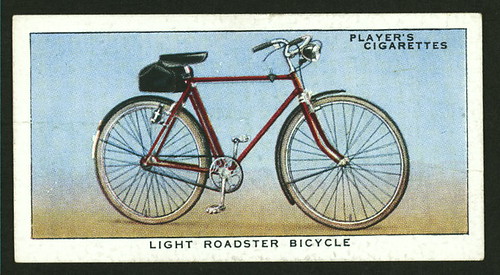Before World War II, tobacco companies included trading cards in their cigarette packaging, similar to baseball cards included in some modern packages of bubble gum.
In 1939, Player Cigarettes in Great Britain released a series of 50 cycling cards with the help of Mr “Harry” England, the editor of Cycling (today’s Cycling Weekly).
The series briefly covers the history of cycling, describing early and (then) modern bikes, such as this Light Roadster Bicycle, described as “admirably suitable for the young and middle-aged for riding to work, to the allotment, or to school.”

“Fitted with sturdy tyres, a 3-speed hub gear, dynamo lighting and a sensible touring bag, the Light Roadster Bicycle is probably the most popular type of machine used in this country today.”
Most of the several other types of bicycle, including a recumbent “Velocar” introduced “from the continent, are described similarly with mostly positive commentary. I might be projecting, but I think I detect a tiny sneer behind the description of “The American Bicycle,” that heavy, balloon tire classic that lives on in modern day beach cruisers.
The back side of this card describes the American bicycle:
America has the largest motoring population of any country in the world, and cycling in towns and on highways as we know it in Britain is practically non-existent. Hollywood has taken to the bicycles as a “stunt” ; cycling in parks and specially reserved places is becoming popular again for health reasons, but the majority of American bicycles are still sold to boys bred in the belief that travel means going by car, hence the “motorbike” bicycle we illustrate, a typical of Uncle Sam’s cycle factories.
On it, the rider never “goes places,” but enjoys only the pretense of being a “speed-cop.” [ — a motorcycle policeman]
This history of how American bike design diverged so wildly from Europe and Japan is covered in James Longhurst’s excellent Bike Battles: A History of Sharing the American Road. Overwhelming motordom is part of it, but a protectionist trade policy and good old fashioned Not Invented Here and American exceptionalism may also play a role. I recommend that book as a look back at where we’ve been and a hopeful look at where we can go.
